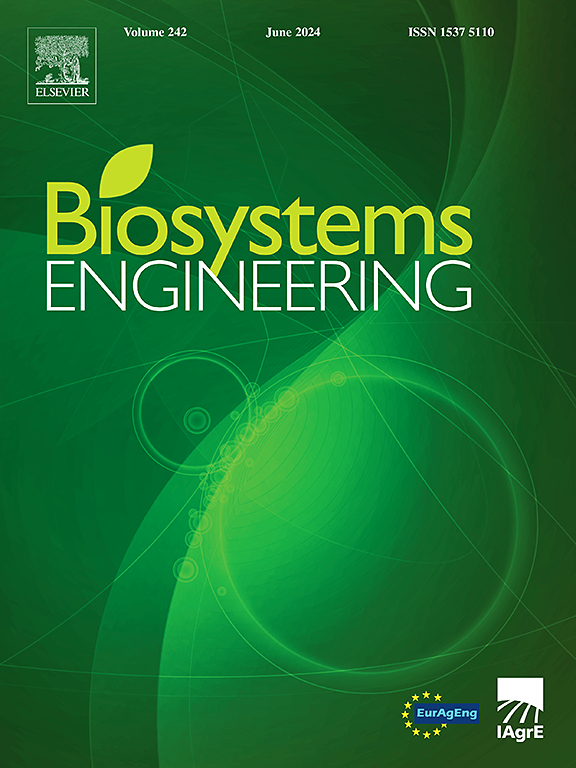测定大型乳品建筑中颗粒物和氨的浓度和排放率的测量优化
IF 5.3
1区 农林科学
Q1 AGRICULTURAL ENGINEERING
引用次数: 0
摘要
采用高采样频率(5 min-PM, 20 min-NH3)多点(12-PM, 10-NH3)连续测量某大型奶牛场建筑空气中总悬浮颗粒物(TSP)、空气动力直径小于2.5 μm的颗粒物(PM2.5)和氨(NH3),时间为1年。通过不同采样时间(D1-D4: 30、15、7、1个月−1)、采样频率(F1-F4: 5/20、60、180、360 min)和采样点数(N1-N4: 12/10、5、3、1)的组合,每种污染物的年平均浓度(AMC)和排放率(AME)的测量方法分别为64种和16种。以D1F1N1测定的数据为真值。采用误差分析和分层聚类方法选择最优组合。结果表明,大型奶牛场建筑物TSP、PM2.5和NH3的基线AMC分别为86.4、28.5、875.0 μ m−3,AME分别为140.6、28.5和3461.1 mg h−1·奶牛−1。采样频率对AMC的影响小于其他两个因素。D1/D2和N1/N2水平分别是确保PM和NH3 AMC监测准确性的关键,而D1- d3水平是量化AME的关键。AMC的测量可分别从D1F1N1的最大值优化到D4、F4、N4水平,AME的测量可优化到D2和F4水平。不同的监测目的(AMC或AME)和不同的污染物类型,优化的测量方法有所不同。本文章由计算机程序翻译,如有差异,请以英文原文为准。
Measurement optimization for determining concentrations and emission rates of particulate matter and ammonia from a large size dairy building
Total suspended particle (TSP), particulate matter less than 2.5 μm in aerodynamic diameter (PM2.5) and ammonia (NH3) in a large-size dairy building were continuous measured for one year with high sampling frequency (5 min-PM, 20 min-NH3) at multi points (12-PM, 10-NH3). A total of 64 and 16 measurement methods for each pollutant were obtained to calculate the annual mean concentrations (AMC) and emission rates (AME), respectively, which was combined by different levels of sampling duration (D1-D4: 30, 15, 7, 1 d month−1), sampling frequency (F1–F4: 5/20, 60, 180, 360 min) and number of sampling points (N1–N4: 12/10, 5, 3, 1). Data measured by D1F1N1 was considered as the true value. Error analysis and hierarchical clustering were applied to select the optimal combinations. Results showed that the baseline AMC of TSP, PM2.5 and NH3 in the large dairy building were 86.4, 28.5, 875.0 μg m−3, respectively, and the corresponding AME were 140.6, 28.5, and 3461.1 mg h−1·cow−1. The effect of sampling frequency on AMC was less significant than the other two factors. The D1/D2 and N1/N2 levels were essential to ensure the monitoring accuracy of AMC of PM and NH3, respectively, while D1-D3 levels were essential to quantify the AME. Measurement of AMC could be optimized from the maximum of D1F1N1 to D4, F4, N4 level, respectively, and corresponding measurement of AME could be optimized up to D2 and F4 level. Optimized measurement methods were varied among different monitoring purposes (AMC or AME) and different pollutant types.
求助全文
通过发布文献求助,成功后即可免费获取论文全文。
去求助
来源期刊

Biosystems Engineering
农林科学-农业工程
CiteScore
10.60
自引率
7.80%
发文量
239
审稿时长
53 days
期刊介绍:
Biosystems Engineering publishes research in engineering and the physical sciences that represent advances in understanding or modelling of the performance of biological systems for sustainable developments in land use and the environment, agriculture and amenity, bioproduction processes and the food chain. The subject matter of the journal reflects the wide range and interdisciplinary nature of research in engineering for biological systems.
 求助内容:
求助内容: 应助结果提醒方式:
应助结果提醒方式:


